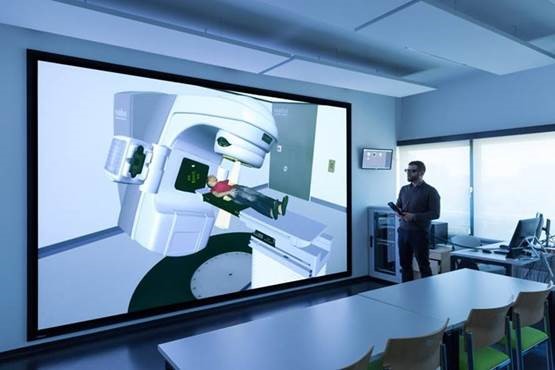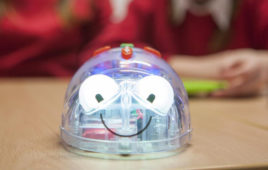
(Credit: University of Vienna)
A combination of a Virtalis ActiveWall and Virtual Environment Radiotherapy Training (VERT) software is enabling radiotherapy treatments to be taught using VR technology, completely eliminating both time pressure and danger to patients.
Already in use at teaching hospitals, the latest institution to take delivery of a VERT system is The University of Applied Sciences, Vienna.
The life-like stereoscopic VR software immerses the student into a typical treatment room at a 1:1 scale, featuring a virtual patient on a treatment table with the linear accelerator above. The student controls VERT using the same controller that is used for real linear accelerators, with the controller both able to move the both the virtual table and the linear accelerator in order to achieve the correct positioning of the patient. The radiotherapy beam is visible as a virtual light beam. CT-sectional images, organs and dose distribution in the body caused by the radiotherapy is represented graphically in 3D.
The installation is the first VERT in Austria.
“Vienna’s VERT system has the Christie Mirage WU12K-M at its heart,” says Sönke Dierking, systems team manager at Virtalis GmbH which was in charge of installation project planning. “Active shutter glasses provide optimal channel separation in the 3D visualisation and the back-projection is also critical, as it eliminates any shadowing. This VERT system is further proof, if proof were needed, that VR has truly arrived in the sphere of interactive learning.”
VERT is able to mimic patient radiation treatment from linear accelerators from Varian, Elektra and Siemens. VERT software was developed by the late Prof Roger Phillips and James Ward of the University of Hull and by Prof. Andy Beavis from Hull & East Yorkshire Hospitals NHS Trust, and is now sold by Vertual Ltd. Swiss company, Medincura in Lucerne, is the distributor of VERT systems in the region. Medincura has integrated the VERT system into a complete training system for radiation therapy. This training system simulates the typical clinical workflow – Therapy Planning System (TPS) – Oncological Information System (OIS) – Virtual Simulation System (ProSoma) – Treatment (VERT).
David Mayerhofer is an instructor and researcher in the BSc programme for radiography at The University of Applied Sciences, Vienna which has approximately 5,400 students. He explains, “Students don’t just learn pure theory – they also learn the practical applications of radiotherapy. With the various simulated treatment rooms, they’re able to practice proper patient positioning. This is extremely important, since each position change leads to a different distribution of radiation doses”.


